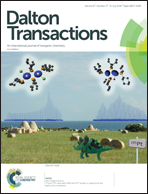Preparation and reactivity of half-sandwich dioxygen complexes of ruthenium†
Abstract
Dioxygen complexes [Ru(η5-C5Me5)(η2-O2){P(OEt)3}2]BPh4 (1) and [Ru(η5-C5Me5)(η2-O2)(PPh3){P(OR)3}]BPh4 (2, 3) [R = Me (2), Et (3)] were prepared by allowing chloro-complexes RuCl(η5-C5Me5)[P(OEt)3]2 and RuCl(η5-C5Me5)(PPh3)[P(OR)3] to react with air (1 atm) in the presence of NaBPh4. Substitution of the η2-O2 in 1–3 by alkenes [CH2![[double bond, length as m-dash]](https://www.rsc.org/images/entities/char_e001.gif) CH2,
CH2, ![[upper bond 1 start]](https://www.rsc.org/images/entities/char_e010.gif) CH
CH![[double bond, length as m-dash]](https://www.rsc.org/images/entities/char_e001.gif) CHCO(O)C
CHCO(O)C![[upper bond 1 end]](https://www.rsc.org/images/entities/char_e011.gif) O] and terminal alkynes (PhC
O] and terminal alkynes (PhC![[triple bond, length as m-dash]](https://www.rsc.org/images/entities/char_e002.gif) CH) afforded [Ru(η5-C5Me5)(η2-CH2
CH) afforded [Ru(η5-C5Me5)(η2-CH2![[double bond, length as m-dash]](https://www.rsc.org/images/entities/char_e001.gif) CH2){P(OEt)3}L]BPh4 (4) [L = P(OEt)3 (a), PPh3 (b)], [Ru(η5-C5Me5){η2-
CH2){P(OEt)3}L]BPh4 (4) [L = P(OEt)3 (a), PPh3 (b)], [Ru(η5-C5Me5){η2-![[upper bond 1 start]](https://www.rsc.org/images/entities/char_e010.gif) CH
CH![[double bond, length as m-dash]](https://www.rsc.org/images/entities/char_e001.gif) CHCO(O)C
CHCO(O)C![[upper bond 1 end]](https://www.rsc.org/images/entities/char_e011.gif) O}{P(OEt)3}2]BPh4 (5) and [Ru(η5-C5Me5){
O}{P(OEt)3}2]BPh4 (5) and [Ru(η5-C5Me5){![[double bond, length as m-dash]](https://www.rsc.org/images/entities/char_e001.gif) C
C![[double bond, length as m-dash]](https://www.rsc.org/images/entities/char_e001.gif) C(H)Ph}{P(OEt)3}2]BPh4 (6) derivatives. Protonation of dioxygen complexes 1–3 with triflic acid yielded phosphate complexes [Ru(κ1-OTf)(η5-C5Me5){P(O)(OEt)3}2] (7) and [Ru(κ1-OTf)(η5-C5Me5){P(O)Ph3}{P(O)(OMe)3}] (8). A reaction path for the formation of complexes 7 and 8 is proposed by DFT studies. Besides phosphate complex 7, protonation of 1 under a CH2
C(H)Ph}{P(OEt)3}2]BPh4 (6) derivatives. Protonation of dioxygen complexes 1–3 with triflic acid yielded phosphate complexes [Ru(κ1-OTf)(η5-C5Me5){P(O)(OEt)3}2] (7) and [Ru(κ1-OTf)(η5-C5Me5){P(O)Ph3}{P(O)(OMe)3}] (8). A reaction path for the formation of complexes 7 and 8 is proposed by DFT studies. Besides phosphate complex 7, protonation of 1 under a CH2![[double bond, length as m-dash]](https://www.rsc.org/images/entities/char_e001.gif) CH2 atmosphere (1 atm) afforded acetic acid. Treatment of complexes 7 and 8 with tBuNC afforded the tris(isocyanide) derivative [Ru(η5-C5Me5)(tBuNC)3]BPh4 (9). The complexes were characterised spectroscopically (IR and NMR) and by X-ray crystal structure determination of 1, 2 and 3.
CH2 atmosphere (1 atm) afforded acetic acid. Treatment of complexes 7 and 8 with tBuNC afforded the tris(isocyanide) derivative [Ru(η5-C5Me5)(tBuNC)3]BPh4 (9). The complexes were characterised spectroscopically (IR and NMR) and by X-ray crystal structure determination of 1, 2 and 3.



 Please wait while we load your content...
Please wait while we load your content...